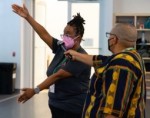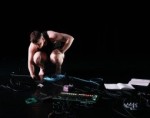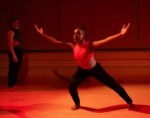
A Spoon Becomes a World of Crip* Possibilities
by Rachel DeForrest Repinz
It begins with a cup of tea and a spoon.
Kinetic Light’s DESCENT: Online & In-Depth weaves together an intimate online space for audience members to join from around the globe. Alice Sheppard and Laurel Lawson, Kinetic Light artistic team and DESCENT dancers, and Michael Maag, scenographer for Kinetic Light, welcome us into the online space, inviting us to engage with a pre recorded conversation from an afternoon rehearsal in New York. I steep a cup of tea, listening and looking in as the trio spends an hour reflecting on the origins of DESCENT. What begins with a formal welcome, quickly shifts to comfortable conversation amongst friends, reflecting on their work together, and how disability justice and aesthetics liberate themselves and their work. As I listen in to the conversation, the live chat activates with affirmations, questions, and real-time conversation between the artists and audience. From my tiny Brooklyn apartment, I bear witness to the conversation, both as an outsider and as an active member of this new virtual space we are cultivating together.
What would it be like to roll down the stem of a spoon and into its curved bowl? This is the origin of DESCENT. Maag recalls one of his first conversations with Sheppard, over cups of tea: “there was a spoon nearby and we bent the spoon… we moved the spoon around and we decided it would be really fun to roll down the stem of the spoon into the bowl of a spoon… [we] must've spent like four hours at that poor coffee shop. It was fantastic.”
As we transition from the conversation space into the viewing of DESCENT, we are invited to choose our own paths. With a plethora of access-centered viewing options to engage with, I opted for the version of DESCENT with spacious audio descriptions focused on plot and emotion, along with open captions. This layer of the performance offered a new way to experience the performance, highlighting the characters’ emotions, stories, and emphasis on queer love. Nestled onto my couch under a warm blanket with my now cooling cup of tea, I enter into the world of DESCENT.
Sheppard and Lawson crawl atop a larger-than-life “spoon,” inviting the massive ramp-like structure into the choreography. As they move, the unwritten stories of Venus and Andromedea, a pair that has never once been documented within the same story (according to Lawson and Sheppard during their pre-recorded interview), unfold. Inspired by Rodin’s Toilette of Venus and Andromeda, they consider what would happen if these mythological women met. Alice asks, How do we take this into our body? How do we crip them? Crawling, swirling, reaching, and caressing, the pair (along with audio describer Cheryl Green) weave together narratives of queer love, assumptions of femininity, connection, and belonging — bending the spoon.
As curiosity turns into tender knowing, what begins as a duet finds a soft landing as a group work. Guided by Sheppard and Lawson’s delicious movement, the steady bend of the spoon (ramp), transcendent soundscape, and soft glow of the projected night sky become living characters within the world of DESCENT. As the work launches into its climactic finale, Sheppard and Lawson cling to the highest peak of the ramp’s edge, their bodies and wheelchairs intertwined with one another. With an abrupt flash of white light the nonhuman characters disappear, leaving only Sheppard and Lawson together in darkness. With lights gone, music turned to silence, and the ramp hiding in the cover of darkness, Sheppard and Lawson, Andromeda and Venus, only have each other to cling to.
The silence permeates through the screen, and I close my eyes to take a deep breath. The final image of Sheppard and Lawson is still etched into the backs of my eyelids and my tea has gone cold. As I pick up my spoon, I notice a small clump of honey still clinging to its edge, mirroring Sheppard and Lawson in their final moment. I grin and walk down the hall to refill my cup. As I rescue the glob of honey from the edge of my spoon, I bend the spoon slightly, now knowing what it’s like to roll down its edge and into the curved bowl.
Note: The term ‘crip’ has been reclaimed by those within the disabled community, used widely within the fields of disability and cultural studies, and popularized by scholars including McRuer Sandahl.
Homepage Image Description: Laurel Lawson, a white person with cropped hair, balances above Alice Sheppard with arms spread wide, wheels spinning. Alice, a multiracial Black woman with coffee-colored skin and curly hair, opens her arms wide to receive her in an embrace.
Article Page Image Description: Laurel Lawson and Alice Sheppard hold each others’ forearms, chins lifted as they extend the other curved arm to the side, in a counterbalance turn. Alice is a Black multiracial woman with blond curly hair and coffee-colored skin; Laurel is a white person with cropped teal hair. They both wear gray leggings and leather-like sleeveless tops that resemble armor or petals. Projected illustrated figures dance across the purplish stage as a mountain range appears, silhouetted in the sunset, in the background (designed by Michael Maag).
DESCENT: Online & In-Depth, Kinetic Light, online, Oct. 26 & 28.
By Rachel DeForrest Repinz
November 3, 2023










